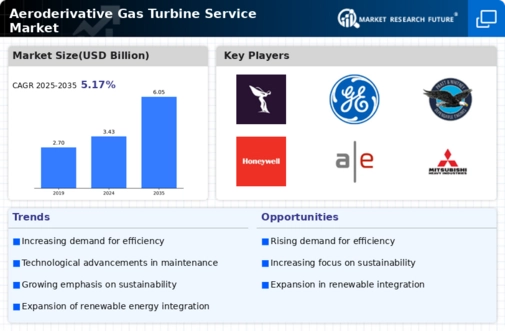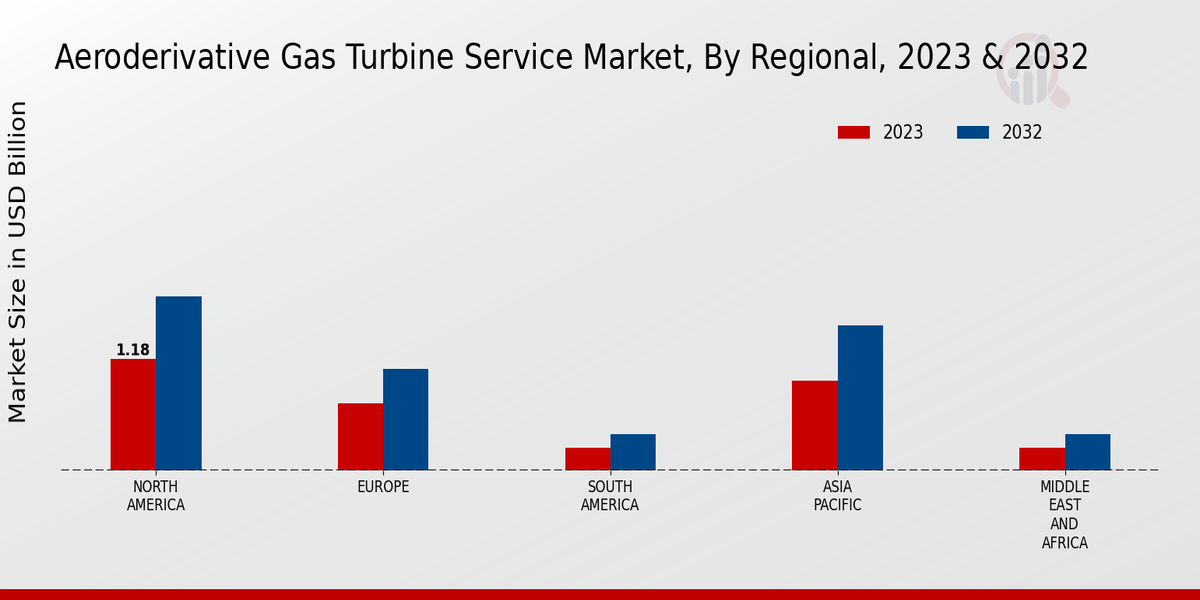Expansion of Renewable Energy Integration
The integration of renewable energy sources into existing power grids is a pivotal driver for the Aeroderivative Gas Turbine Service Market. As nations strive to meet renewable energy targets, the need for flexible and reliable backup power sources becomes paramount. Aeroderivative gas turbines can swiftly respond to fluctuations in renewable energy generation, such as solar and wind, thereby ensuring grid stability. Recent statistics suggest that the share of renewables in the energy mix is projected to increase significantly, necessitating the deployment of aeroderivative turbines to complement these sources. This integration not only enhances energy security but also supports the transition towards a more sustainable energy landscape, thereby fostering growth in the aeroderivative gas turbine service sector.
Rising Industrialization and Urbanization
The ongoing trends of industrialization and urbanization are driving the Aeroderivative Gas Turbine Service Market. As urban areas expand and industrial activities increase, the demand for reliable and efficient power generation solutions intensifies. Aeroderivative gas turbines, known for their ability to provide quick and flexible power, are becoming essential in meeting the energy needs of rapidly growing cities and industries. Market analysis indicates that regions experiencing high rates of urbanization are likely to see a corresponding rise in the demand for aeroderivative gas turbine services. This correlation suggests that as more industries seek to establish operations in urban centers, the need for efficient power generation will continue to propel the growth of the aeroderivative gas turbine service market.
Technological Innovations in Turbine Design
Technological innovations in turbine design are reshaping the Aeroderivative Gas Turbine Service Market. Advances in materials science and engineering have led to the development of more efficient and durable turbine components. These innovations enhance the performance and reliability of aeroderivative gas turbines, making them more appealing to operators. For instance, the introduction of advanced cooling techniques and improved aerodynamics has resulted in turbines that can operate at higher temperatures and pressures, thereby increasing their efficiency. Market data indicates that these advancements could lead to a reduction in operational costs by up to 15%, further incentivizing the adoption of aeroderivative gas turbine services. As technology continues to evolve, the market is likely to witness a proliferation of new service offerings tailored to these advanced turbine designs.
Regulatory Support for Cleaner Energy Solutions
Regulatory frameworks promoting cleaner energy solutions are significantly influencing the Aeroderivative Gas Turbine Service Market. Governments worldwide are implementing stringent regulations aimed at reducing greenhouse gas emissions and promoting cleaner technologies. Aeroderivative gas turbines, with their lower emissions profile compared to traditional fossil fuel-based power generation, are well-positioned to benefit from these regulatory trends. Recent policy initiatives have incentivized the adoption of cleaner technologies, which could lead to increased investments in aeroderivative gas turbine services. This regulatory support not only enhances the market's attractiveness but also aligns with global sustainability goals, suggesting a favorable environment for growth in the aeroderivative gas turbine service sector.
Increasing Demand for Efficient Power Generation
The Aeroderivative Gas Turbine Service Market is experiencing a notable surge in demand for efficient power generation solutions. As energy consumption continues to rise, industries are seeking technologies that offer higher efficiency and lower emissions. Aeroderivative gas turbines, known for their quick start-up times and operational flexibility, are becoming increasingly attractive. According to recent data, the efficiency of these turbines can reach up to 40%, making them a preferred choice for power generation. This trend is likely to drive investments in aeroderivative gas turbine services, as companies aim to optimize their energy production capabilities while adhering to stringent environmental regulations. The growing emphasis on reducing carbon footprints further propels the demand for these advanced turbine services, indicating a robust growth trajectory for the market.


















Leave a Comment